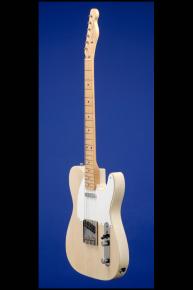A Near Mint 1957 'V' Neck Telecaster
This fifty-three year old Blond beauty weighs just 6.80 lbs. and has a medium to thick 'V' neck profile with a nice fat nut width of just over 1 5/8 inches and a scale length of 25 1/2 inches. Solid ash body and fretted maple neck with 21 original small frets and black dot position markers. Single butterfly string tree. Headstock decal with "Fender" spaghetti logo in silver with black trim and "Telecaster" in black below it. Individual "single-line" Kluson Deluxe tuners with oval metal buttons stamped on the underside "D-169400 / Patent No." One plain metal-cover "black-bottom" pickup with slot-head adjusting screws (at neck) with an output of 6.26k, and one black six-polepiece "copper-coated metal plate bottom" pickup with staggered polepieces (angled in bridgeplate) with an output of 6.24k. Single-layer white ABS (.060 inches thick) pickguard with five screws. Two controls (one volume, one tone) plus three-way "CRL 1452" switch and original Daka-Ware black plastic "Top-Hat" tip, all on metal plate adjoining pickguard. Shorter chrome knobs with flat domes and knurled sides. Telecaster combined bridge/tailpiece with three, quarter inch steel, smooth saddles. Four-bolt neck plate with serial number ("-22094") between the top two screws. The neck is dated in pencil "8-57". The bridge pickup cavity is dated in pencil "8-57". The potentiometers are stamped "304 7XX" (Stackpole 1957). The last two numbers which are that week of 1957 are obscured by solder on both pots. This guitar is in near mint (9.25) condition with just a tiny amount of light edgewear. The lovely grain of the ash body shows very well through the finish, and this wonderful gem is quite simply one of the best sounding "white guard" Telecasters that we have handled! With original 1957-58 Fender Catalog, original Fender hang tag with matching serial number and with the price of $238.00, original brown leather strap, bridge cover and guitar lead. Housed in the original Fender tweed hardshell case with light red plush lining (9.25).
"Leo Fender's new solidbody was the instrument that we know now as the Fender Telecaster, effectively the world's first commercially successful solidbody electric guitar...The guitar was originally named the Fender Esquire and then the Fender Broadcaster, and it first went into production in 1950. It was a simple, effective instrument. It had a basic, single-cutaway, solid slab of ash for a body, with a screwed-on maple neck. Everything was geared to easy production. It had a slanted pickup mounted into a steel bridge-plate carrying three adjustable bridge-saddles, and the body was finished in a yellowish color known as blond. It was unadorned and like nothing else. It was ahead of its time (Tony Bacon, 50 Years of Fender, p. 10).
"Both the Telecaster and the Esquire kept their basic 1951 appointments until the mid-50s. In retrospect, their most striking features -- at least cosmetically speaking -- are a typical yellowed blonde finish (a.k.a. 'butterscotch' finish) and a black pickguard, hence the often cited notion of early 'black guard' Tellies. The combination of the two actually gives a distinct look to the early 50s models, which are otherwise considered by many as the ultimate classic Telecaster guitar because of their tone... Prior to mid-54, the only major evolution dealt with the Telecaster wiring circuit which was modified by Leo Fender in 1952. The second control, originally construed as a "blender" or a "pan control," was turned into a real tone control as on the Esquire. Conversely, this modification prohibited any two-pickup combination since Leo retained the pre-set boomy tone selected in the switch forward position. The 2nd generation of black guard Telecaster thus has a tone control, but it is functional only in the middle (neck p.u.) and rear (bridge p.u.) switch positions. This circuit provides what catalogues then termed "short duration rhythm tone," "full concert tone" and "lead or take-off tone." Besides its peculiar hue, the original blonde finish nicely showcases the ash body heavy grain pattern that later whiter finishes would subdue...[1954] marks the beginning of a number of changes in the appointments of Telecaster guitars. By Fall, the bakelite black guard was replaced by a single ply white trim and a few months later steel superseded brass for the bridge saddles. FENDER also changed the finishing process of the blonde finish... The typical 'butterscotch' colour gave way to a creamier shade which would soon evolve into a lighter off-white finish. Finally, 1954 is also the year when the serial number was removed from the bridge plate to be stamped on the neck anchor plate... Beyond these cosmetic features, a more dramatic evolution took place in 1955. The bridge pickup was modified to incorporate staggered pole pieces in place of the flush level-poles of the original design... Finally, the round clubby neck of the post-1950 guitars evolved into pronounced 'V' feel by 1955 and until early 1958 'boat necks' were the rule on most Fender instruments... At the end of 1956, Telecaster guitars no longer looked or even sounded exactly the same as the 1951 models... In the course of 1958, necks gradually changed for a flatter cross section" (A.R. Duchossoir, The Fender Telecaster, p. 16).
"V necks (a.k.a. "boat necks") reappeared in the course of 1955 and became a standard pattern over 1956 and 1957, with a variable cross-section ranging between, say anything like .86"/.94" at the first fret and .97/1.02 inches at the 12th fret. Early 1958 necks still have a slight V feel, but a much flatter profile was quickly adopted with measurements steadily below .90 inches at the first fret and 1.00 inch at the 12th fret. Rosewood necks made after mid-59 show a really flat pattern with measurements often below .80 and .92 inches." (A.R. Duchossoir, The Fender Telecaster, p. 53).
Translate:














